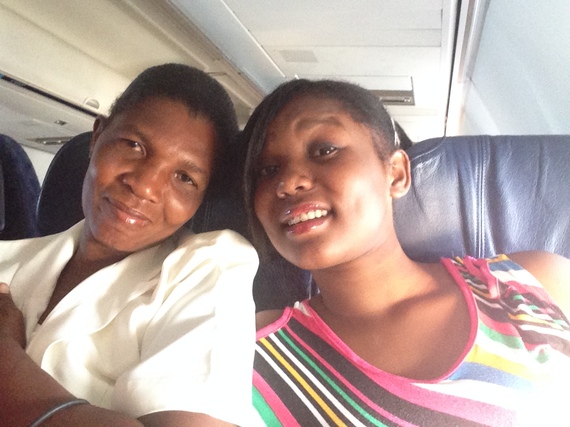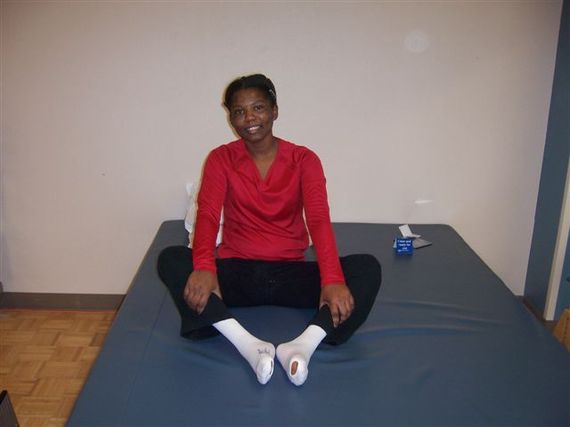 This story begins with the earthquake, but it is not about the earthquake.
This story begins with the earthquake, but it is not about the earthquake.
Marie Ginie was 14 when the earthquake destroyed her home. No one was inside that day, and each of her siblings and both of her parents were unharmed. Time passed and 15 months later Marie Ginie’s mother and father had rebuilt two walls. These walls formed a single corner, which was covered by a tarp. In May, a storm came, and a violent wind filled the tarp like a sail. The force of the sail pulled the wall up, and then brought it crashing down.
Marie Ginie was doing her homework under the tarp when she looked up to see the blocks falling toward her younger brother Mendes. Marie Ginie dove on top of him, likely saving his life, and surely altering hers forever. The wall fractured her spinal column, paralyzing her from the waist down.
I wasn’t there that day.
How do I know this?
Marie Ginie’s mother told me.
This story is about mothers. About courageous and defiant Haitian mothers. About one Haitian mother, whose name is Mimause.
There are times in life when formulas don’t help, when logic falls short, and when words are weak. There are times when the look in a person’s eye possesses a force beyond reason. An unmistakable look shown from Mimause’s eyes when she brought Marie Ginie to the hospital. Like firelight on steel, it shown bright from the first moment they entered. This look said very clearly, very simply, and with not even a hint of a shadow of a doubt:
This is my daughter, and my daughter will find help.
Marie Ginie and her mother went out in a pickup truck that night of the storm. Marie Ginie lying on her back in unbearable pain. Mimause singing, praying and soothing, as they bumped along in desperation. They tried several hospitals before reaching ours. X-rays showed flexion-distration fracture-dislocation of T-12/L-1, which is to say, Marie Ginie was in trouble. Not only was her long term future uncertain, but high level specialty surgery was needed immediately in order to stabilize her spine and protect her from further danger.
Days passed and our Haitian leadership brainstormed, emailed international partners for help, and consulted with experts inside the country. With each day the staff became closer to Marie Ginie and Mimause, who despite their situation, were grateful, positive, even funny.
The light in Mimause’s eyes had not dimmed.
Her daughter would find help.
During these days an American friend of mine explained to Mimause that with physical therapy, Marie Ginie could live a full life, even if she did not recover the ability to use her legs (which we knew even then was very unlikely).
“We can help train you and the family, show you how to do the transfers. There are ways to transfer from the shower into the chair. From bed into the chair, to cook in the kitchen, to organize to live life fully.”
Mimause smiled with compassion and laughed softly.
“Shower? Bed? Kitchen?” she said. “We don’t have those things, dear.” A simple clarification, which she spoke without reproach or bitterness. I glanced over at Raphael, the hospital administrator at the time. We’ll have to work on those things too, said his eyes.
A few days later we were off to the Mayo Clinic in Rochester, MN, where Marie Ginie would receive surgical and physical therapy services free of charge, thanks to our friends and partners at Mayo. Through it all Mimause remained at her side. Guarding, supporting, laughing, pushing.
When Marie Ginie cried, Mimause squeezed her hand, speaking calm words with calm eyes. When Marie Ginie needed to smile, Mimause danced and sang until the laughter spilled out. When Marie Ginie needed to be told to buck up and do her therapy, Mimause told her to buck up and do her therapy. Over the course of several weeks mother and daughter adjusted to American food and culture, practiced rehab and therapy, learned a bit of English, and prepared themselves to return to Haiti.
Once back in Haiti, Mimause, Marie Ginie, and her younger brothers and sisters, became members of our family at the hospital. Every time Mimause went to visit her husband and children at her still crumbled home, she returned with a huge smile and food and fresh juice for the staff, nurses, and anyone else lucky enough to be in the area.
It was mind boggling, her positivity. Her energy, strength, her vitality, her warmth and steadfastness.

The team in Haiti began to build the family a new house a few weeks after Marie Ginie’s return to Haiti, this thanks to the generosity of a stateside donor who, like all of us, found the story and strength of Marie Ginie and Mimause undeniable. We found place for Marie Ginie and her siblings in our schools in Haiti, and Mimause now participates in a micro credit program. There are struggles. Marie Ginie has experienced other health issues since returning, but she is well and in good spirits. Getting her to school can be a challenge. The family, like many, struggle to make ends meet. Despite great progress, what is clear about Marie Ginie’s future, is that it will not be easy. But through it all stands Mimause and her eyes. Steadfast and saying wordlessly, I will find help for my daughter. There seems no other option.
The other day on public radio I heard a story about what was being termed grievability. I’m trying to understand what it means. I mean, I know what it means. It means 50 more people die of a suicide bombing in a market somewhere and if we’re paying attention we feel sad, and we sigh. It means that children are dying at heartbreaking rates in parts of this world, and we are not sure of how to feel each loss from our cars, as we glide along paved roads from one place to the next.
When this concept of grievability came through the speakers, I’d just returned from a trip to Haiti, where I’d been to several funerals. I tried to think about this new word, what it meant to me, this grievability, that the story grappled with.
What it comes down to, I think, is that a mother is a mother, and her child is her child, and the word grievability means nothing to her and never will. It means that the world, and the way it’s organized, can be strange and terribly flawed, but that the heart of a mother is neither.
It means that if we are to fight for anything, it might simply be for the right of mothers to fight for their children. If we can’t fight for their right to fight, we are surely lost.
How do they exercise this right to fight in Haiti? Haitian mothers walk for hours, leaving well before day break, to make an appointment for their child at the hospital. Haitian mothers hold their babies in the air all night, allowing them to sleep unaware of water rushing into makeshift homes. Haitian mothers spend all day at the market trying to earn enough to bring home something to eat. Haitian mothers are doctors and nurses, with problems of their own, still courageously absorbing the pain and struggles of their patients.
These mothers fight for their children with every tool they can find, and are often left with only their pleading eyes. Like Mimause, declaring silently, I will find help for my daughter that night, these scenes, these eyes, are flashed throughout the country many times a day.
Stand up for their right to fight for their children, and do so in honor of your own mother this Mother’s Day.
